Competition Maneuvers of
Keluarga Pencak Silat
Nusantara
Rapid Journal, Vol 7, No.1 (Book 23, 2002: 37 – 39)
© O'ong Maryono
www.kpsnusantara.com
Demonstrated by Miftah Laewae, trainer KPS Nusantara Ramkamhaeng University (Bangkok, Thailand)
The Keiuarga Pencak Silat (KPS) Nusantara was one of the perguruan, which contributed to the process of establishing pencak silat as a sport in Indonesia. To do so many technical reforms had to be implemented through effective training methods. By adapting the methodology of Western sports science - in particular the 'synthesis-analytical' or 'part to whole to part' method - the founders of KPS Nusantara designed a new method for training mastery in basic techniques, which was called 'dasar-jurus-urai' (basic movements—sequel movement—analysis of movements).
 |
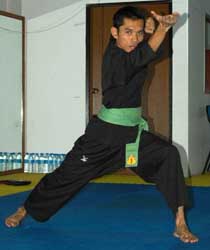 |
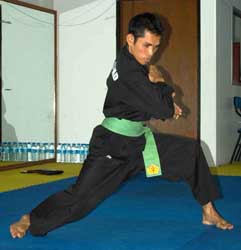 |
(1) Standing Position XII (sikap pasang dua belas) |
(2) Standing Position I (sikap pasang satu) |
(3) Standing Position IV-close elbow (sikap pasang empat tutup siku depan). |
In the methodological approach, the training begins with the study of the most basic movement elements, which are then configured into one complete movement. These complete movements are then combined into one sequence comprising several movements (jurus). Next, the jurus are broken down again to achieve perfection of form. The sequences become more complex as the level of difficulty increases: from exercise maneuvers, to competition maneuvers, and ultimately, to defensive maneuvers.
In the jurus pertandingan or sequel of competition movements, the pesilat before engaging in the fight with the opponent must carry out certain steps (langkah) and standing positions (sikap pasang). Here we will be describing the first sequel of competition maneuvers consisting of both defensive and offensive techniques.
]urus Pertandingan I
Defense & Attack Tactics
Standing position XII (sikap pasang dua belas)
As we have seen in the previous edition, in this position the pesilat signals that he/she is ready to fight with the fists close to the chest, before entering into action by slowly opening the left hand, while the right hand remains in a fist and the right foot steps back. Moving close to the opponent the body winds down slowly changing to standing position I (sikap pasang satu).
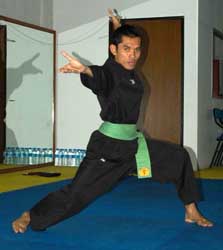 |
 |
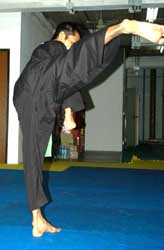 |
(4) Open Standing Position IV - preparation sweep (sikap pasang empat -- persiapan sapu). |
(5) Right leg sweep and jumping (sapu depan bawah). |
(6) Side kick attack (tendang "T" ). |
From this position, a pesilat normally carries out sudden attacks, using hand strikes in combination with kick strikes, which can be eventually followed by throwing techniques to pull down the opponent. At the same time it also allows the pesilat to wait for an opponent's attack and then use the hands to implement deadlock techniques to paralyze his/her hands and legs. The pesilat can move closer with right stepping forward and use the elbows downwards to break the opponent's offensive. By slowly opening the hands, the pesilat enters into standing position IV (sikap pasang empat).
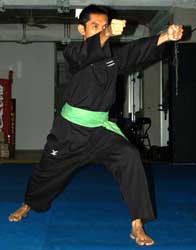 |
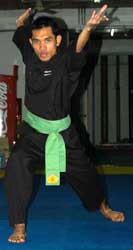 |
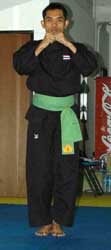 |
(7) Double stikes (papas). |
(8) Flying Eagle (elang melayang) |
(9) Stand-by Position (sikap siap). |
Standing position IV looks vulnerable to attacks, but actually is meant to invite the opponent's offensive so as to employ deadlock techniques to paralyze his/her movements. By allowing swift movements to close in on a target, it works most effectively with emotional opponents who loose their control and forget to maintain a distance.
From sikap pasang IV the pesilat can use some trickery by taking distance from the target with a right leg swerve while jumping forward with a side kick. After the right leg is landed, he/she can move forward with fast left steps in a double strike attack.
To close this strike the pesilat steps back twice to finish in a flying eagle standing position (elang melayang) before returning to the standing position (sikap siap) in preparation for the second sequel of competition techniques (jurus pertandingan) which will be discussed in the next edition.
back to main page • back to articles from Rapid Journal • next article